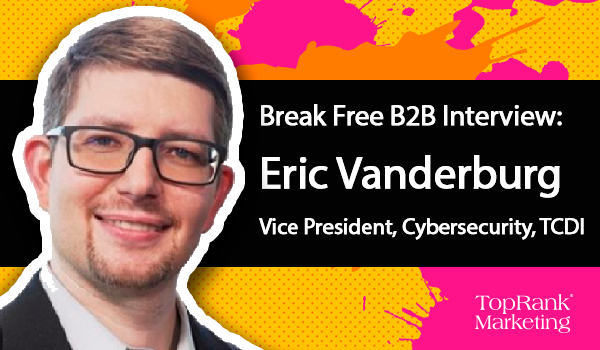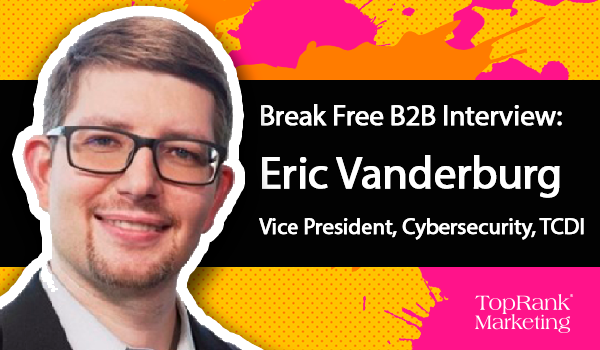
For more than a decade our team at TopRank Marketing has fostered a potent community of leading influencers, developing close relationships with subject matter experts in a wide variety of industries.
When it comes to B2B influencer marketing, it’s only natural to wonder just what an industry influencer actually looks like?
In our third season of Break Free B2B Marketing video interviews, we’re continuing in-depth conversations with a powerful selection of top B2B influencers, and taking a close look at the issues that each expert is influential about in their industry.
Every successful B2B influencer has a rare mix of the 5 Ps — proficiency, personality, publishing, promotion, and popularity — as our CEO Lee Odden has outlined in “5 Key Traits of the Best B2B Influencers.”
Combining every one of these qualities and plenty more is Eric Vanderburg, vice president of cyber security at TCDI, who we’re thrilled to be profiling today.
Cybersecurity has always been a priority for smart B2B marketers and business owners, but it’s never been more of a concern than it is right now. In fact, a recent CSO survey has found that over 60% of small and medium business owners are more concerned now about security risks for their remote employees than they were at the beginning of the pandemic.
That fear isn’t without good cause. Phishing attacks are up. People are spending more time online than ever before — not just working, but shopping, chatting, browsing, and beyond. Potential pathways to risk are everywhere and that begs the question: how do you keep your employees and data safe?
Luckily, while there are a lot of risks out there, there are also industry experts leading the charge when it comes to avoiding them. Experts like Eric Vanderburg. Eric has made a name for himself helping equip businesses with the right tools and knowledge to keep their cybersecurity practices effective and up-to-date. That’s the reason why our Joshua Nite interviewed him for today’s new episode six of the Break Free B2B Marketing Interview series.
Break Free B2B Interview with Eric Vanderburg
If you’re interested in checking out a particular portion of the discussion, you can find a quick general outline below, as well as a few excerpts that stood out to us.
- 3:01 – Cybersecurity progress separate from the pandemic
- 4:10 – What can remote workers do at home to support better security for their organizations?
- 5:27 – Are recent cybersecurity changes here to stay or are we going to regress to the mean?
- 7:01 – Any cybersecurity mistakes being made that should be addressed?
- 8:10 – What will the cybersecurity landscape look like when things start to open up again?
- 9:20 – What can executives or B2B leaders do to better plan for the future?
- 11:34 – How do you become a thought leader in the cybersecurity space and build an audience?
- 15:03 – Does having a large following ever get in the way of saying what you want to say?
- 18:56 – What makes Eric more (or less) likely to want to be involved in a project?
- 21:07 – Where can people find Eric if they want to get in touch?
Josh: Have you seen any people that were truly prepared for something like this to happen, or has it generally been folks in a bit of a scramble?
Eric: I wouldn’t say anybody’s been fully prepared — there’s been a little bit each company’s had to do. Some companies have been a little bit better prepared. On the technology side, they had what they needed to enable employees to work from home and have the security in place, and they had good procedures and training. But then, you know, they miss out on some other elements and communication breaks down. And now business email compromise was their downfall, or they got all the others and they didn’t do the training, or they had issues implementing the technology, and vulnerabilities or other issues allowed attackers in. So you know, there’s a lot of different things you have to do to be secure. And with this pandemic, it’s caused many companies to have to react. Unfortunately, when you’re reacting without necessarily having a plan in place, it introduces faults and errors.
Josh: We’ve talked a lot about — when we talk about the pandemic — how people’s five year plan suddenly became a five week plan or a five day plan. I can imagine there are just a ton of moving pieces that people had to consider as they move forward?
Eric: Yes, there really were these complete changes in the way we do business, and not one that companies necessarily plan for somewhere along the line — distributing the workforce and utilizing more contract work, or using us as part of their digital transformation. But others were just blindsided by the whole thing.
“Unfortunately, when you're reacting without necessarily having a plan in place, it introduces faults and errors.” — Eric Vanberburg @vtamethodman #BreakFreeB2B Click To TweetJosh: Are you seeing that as some of these things are rolling out, that there are things that people are overlooking, or getting wrong, or making mistakes that you’d want to correct?
Eric: Yes, well, there’s quite a few. When a lot of companies that have employees who start working from home, many are using personal equipment, maybe they didn’t have a company device, or have a way of properly managing those. So we’ve had a huge influx out of BYOD — bring your own device — and some companies weren’t ready for that. They didn’t have a process in place that others were able to take care of with the right approach, either securing those devices with endpoint agents, or just taking the personal device, not really out of the mix, but connecting them into virtual desktops and keeping local resources. And that’s helped to secure it, and also giving them the same applications and everything else that they had when they were in the workplace.
Josh: I think you address pretty well some of the steps that people can take to solve some of these security issues. So let’s talk about when things are starting to open up again. What do you think that the cybersecurity landscape is going to look like as that starts to happen?
Eric: I think that we’re going to certainly have quite a few new players. I think we’re also going to have companies who are much more agile, or used to using some of those resources they are utilizing, which could be in addition to the regular workforce — a lot of other outside consultants or flex resources. We’re going to see fewer people in the office, and maybe some offices closing down and opening up other regional places because it’s easier to work remotely and to coordinate. Certainly a lot more use of technologies to help coordinate and share, your project management type tools and communication platforms and all that — those are have already seen a big surge. I think we’re going to see a lot more there.
“We're going to see fewer people in the office, and maybe some offices closing down and opening up other regional places because it's easier to work remotely and to coordinate.” — Eric Vanberburg @vtamethodman #BreakFreeB2B Click To TweetKeep your eye on the TopRank Marketing Blog and subscribe to our YouTube channel for more Break Free B2B interviews. Also check out episodes from season 1 and season 2.
Take your B2B marketing to new heights by checking out out previous season 3 episodes of Break Free B2B Marketing:
- Episode 1: Kevin L. Jackson, GC GlobalNet — The Future of Cloud Computing
- Episode 2: Tim Crawford, AVOA — The New Normal
- Episode 3: Oliver Christie, PertexaHealthTech — The Future of Artificial Intelligence
- Episode 4: Liam McIvor Martin, Time Doctor — Trends in Remote Work
- Episode 5: Sarah Barnes-Humphrey, SHIPZ — The Future of Supply Chain



